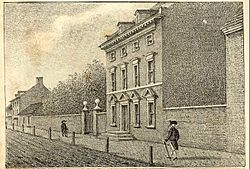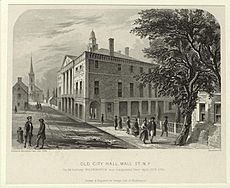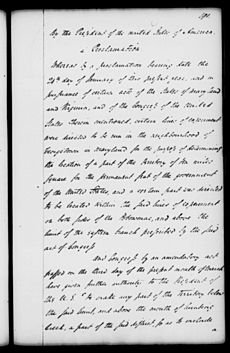Residence Act facts for kids
 |
|
| Long title | An Act for Establishing the Temporary and Permanent Seat of the Government of the United States |
|---|---|
| Enacted by | the 1st United States Congress |
| Citations | |
| Statutes at Large | ch. 28, 1 Stat. 130 |
| Legislative history | |
|
|
| Major amendments | |
| Act to allow the capital to encompass areas to the south of the Eastern Branch, including Alexandria, Virginia (1791), ch. 17, 1 Stat. 214–215 Act to retrocede Alexandria County, D.C. to the State of Virginia (1846), ch. 35, 9 Stat. 35 |
|

The Residence Act of 1790 was an important law passed by the First U.S. Congress. It was signed by President George Washington on July 16, 1790. This law decided where the permanent capital city of the United States would be.
The Act said the new capital would be built along the Potomac River. It also gave President Washington the power to choose the exact spot and hire people to manage the project. The law set a deadline: the capital had to be ready by December 1800. While the new city was being built, Philadelphia was chosen as the temporary capital. Before this, the government was working from New York City.
Congress passed the Residence Act as part of a deal called the Compromise of 1790. This deal was worked out by important leaders like James Madison, Thomas Jefferson, and Alexander Hamilton. Madison and Jefferson wanted the capital to be in the South, along the Potomac River. However, they didn't have enough votes in Congress.
Meanwhile, Hamilton wanted Congress to pass a law called the Assumption Bill. This bill would allow the federal government to take on the debts that states had from the American Revolutionary War. Through the compromise, Hamilton got support for the Potomac site from New York. In return, some Southern delegates who lived near the Potomac agreed to support Hamilton's Assumption Bill.
Contents
Why a New Capital Was Needed
Early Capital Cities of the United States
During the Revolutionary War, the Second Continental Congress met in Philadelphia. But because of British attacks, they had to move several times. They met in places like Baltimore, Lancaster, Pennsylvania, and York, Pennsylvania before returning to Philadelphia.
After the war, the Congress of the Confederation was formed. Philadelphia became the first official seat of government for the new nation. However, Congress did not stay there for long.
The Pennsylvania Mutiny of 1783
In June 1783, a group of angry soldiers marched on Independence Hall in Philadelphia. They demanded to be paid for their service during the war. Congress asked the governor of Pennsylvania, John Dickinson, to send the militia to protect them.
But Dickinson felt sympathy for the soldiers and refused to remove them. This event became known as the Pennsylvania Mutiny of 1783. Because of this, Congress was forced to leave Philadelphia. They moved to Princeton, New Jersey, then Annapolis, Maryland, and Trenton, New Jersey, before finally settling in New York City.
Searching for a Permanent Home
In the mid-1780s, many states offered locations for the nation's capital. But the Continental Congress could never agree on a site. This was because of strong loyalties to different regions. Northern states didn't want a capital in the South, and Southern states didn't want one in the North.
Some suggested having two capitals, one in the North and one in the South. Proposed sites included places like Kingston, New York, Annapolis, Williamsburg, Virginia, and many cities in Pennsylvania.
The New Constitution and the Capital
The United States Congress was created in 1789 after the U.S. Constitution was approved. New York City remained the temporary capital. The new Constitution gave Congress the power to create a special "federal district" outside of any state. This district would be the permanent seat of government. Congress would have full control over it.
During the debates, two main locations were considered. One was on the Potomac River near Georgetown. The other was on the Susquehanna River in Pennsylvania. The House of Representatives approved the Susquehanna site in 1789. The Senate wanted a site on the Delaware River near Germantown, Pennsylvania. They couldn't agree on a final choice.
The Great Compromise of 1790
The debate over the capital came up again in the summer of 1790. At the same time, Alexander Hamilton, who was the Secretary of the Treasury, wanted Congress to pass his financial plan. A key part of his plan was for the federal government to take on the debts that states had from the Revolutionary War.
Northern states had a lot of debt, about $21.5 million, and wanted the federal government to pay it. Southern states, however, had paid off most of their debts. They felt it was unfair for their citizens to pay taxes again to help other states. They also argued that Hamilton's plan went beyond what the new Constitution allowed. James Madison from Virginia led a group of Southern lawmakers who blocked this part of the plan.
How the Deal Was Made
In late June 1790, Thomas Jefferson met Hamilton at President Washington's home in New York City. Jefferson offered to host a dinner to bring Madison and Hamilton together. At this dinner, they reached a compromise.
The Northern delegates agreed to support the Potomac River site for the capital. In return, the Southern delegates would support the federal government taking on the states' war debts. Jefferson wrote a letter to James Monroe explaining this important deal.
Congress agreed to the compromise, and the Residence Act passed by a small margin. Jefferson convinced the Virginia delegates to support the bill with the debt provisions. Hamilton convinced the New York delegates to agree to the Potomac site for the capital.
The Senate approved the bill 14 to 12 on July 1, 1790. The House of Representatives approved it 31 to 29 on July 9, 1790. President Washington signed the Act into law a week later, on July 16. The Assumption Bill also passed shortly after.
What the Residence Act Said
The Residence Act stated that the capital should be located along the Potomac River. It would be between the Eastern Branch (now the Anacostia River) and the Connogochegue Creek. The area could be no more than "ten miles square," which is about 100 square miles.
The Act gave President George Washington the power to choose the exact location and hire a surveyor. He had to make sure suitable buildings were ready for Congress and other government offices by December 1, 1800. The federal government would pay for all public buildings.
The law also said that the laws of the state from which the land was taken would apply in the federal district. So, Maryland laws applied on the east side of the Potomac, and Virginia laws applied on the west side. Once the government officially moved in 1800, Congress would have full authority over the District of Columbia.
To get enough votes for the Assumption Bill, Hamilton also needed support from Pennsylvania delegates. This led to the decision to make Philadelphia the temporary capital for ten years. Congress moved to Philadelphia on December 6, 1790, meeting at Congress Hall.
Building the New Capital

Soon after signing the Act, President Washington started working on the capital project. He and Thomas Jefferson personally oversaw the plans. Even as work began, some people hoped the project would fail and that Philadelphia would remain the permanent capital. Pennsylvania's lawmakers even tried to pass laws to fund federal buildings in Philadelphia.
Although the Act didn't name an exact spot, most people thought Georgetown would be the capital. Washington began looking at the area southeast of Georgetown, near the Anacostia River. Landowners there were willing to sell land for the capital. Washington decided to have several sites surveyed to get more details.
In late November 1790, Washington met with Jefferson in Philadelphia. They decided to place the capital at or next to Georgetown. This spot was just below the Fall Line, which was the farthest point inland that ships could travel.
In January 1791, President Washington appointed a three-person commission to oversee the surveying of the federal district. He also hired Andrew Ellicott as the surveyor. On January 24, Washington told Congress about the chosen site. He suggested that Congress change the Act to include areas south of the Eastern Branch, like Alexandria, Virginia. Congress agreed and passed an amendment on March 3, 1791. However, this amendment still said that public buildings could only be built on the Maryland side of the Potomac River.
On March 30, 1791, Washington issued a special announcement. It set Jones's Point in Virginia as the starting point for the federal district's boundary survey. It also explained how the district's boundaries would be measured.
Designing the City and Buildings
In early 1791, Pierre Charles L'Enfant began creating a plan for the capital city. His plan showed where the "Congress House" (the United States Capitol) and the "President's House" (the White House) would be. Competitions were held to find designs for these buildings.
James Hoban was chosen to design the President's House. For the Capitol, no good designs were submitted at first. Later, a design by William Thornton was chosen. Construction began in September 1793. There were some challenges, including changes to the design that Washington and Jefferson didn't like.
The original idea was to sell land lots in the District to pay for building the federal structures. But not many people wanted to buy the lots. This lack of money caused delays and problems in building the Capitol and other federal buildings.
Moving to the New Capital
President John Adams visited Washington for the first time in early June 1800. Even though the city was still "raw and unfinished," he found the public buildings more complete than he expected. The Senate wing of the Capitol and the White House were almost done.
President Adams moved into the White House on November 1, 1800. His wife, Abigail Adams, arrived a few weeks later. The Senate met in the Capitol for the first time on November 17. On November 22, Adams gave his fourth State of the Union Address to Congress in the Senate chamber. The House of Representatives wing of the Capitol was not finished until 1811, but the House began meeting there in 1807.
In February 1801, Congress passed the District of Columbia Organic Act. This law officially organized the District of Columbia. From then on, Congress became the main governing authority for the district.
Retrocession: Giving Land Back
In 1846, residents of the Virginia part of the District (which was Alexandria County and the City of Alexandria) asked Congress to return their land to Virginia. Congress agreed, and about 31 square miles of territory were given back. This left 69 square miles of land originally from Maryland as the current area of the District of Columbia.
Images for kids
-
A sketch of the future Washington, D.C. by Thomas Jefferson in March 1791.
-
The Residence Act was passed in 1790 while Congress was meeting at Federal Hall in New York City.
-
The President's House in Philadelphia, where the President lived from 1790 to 1800.









